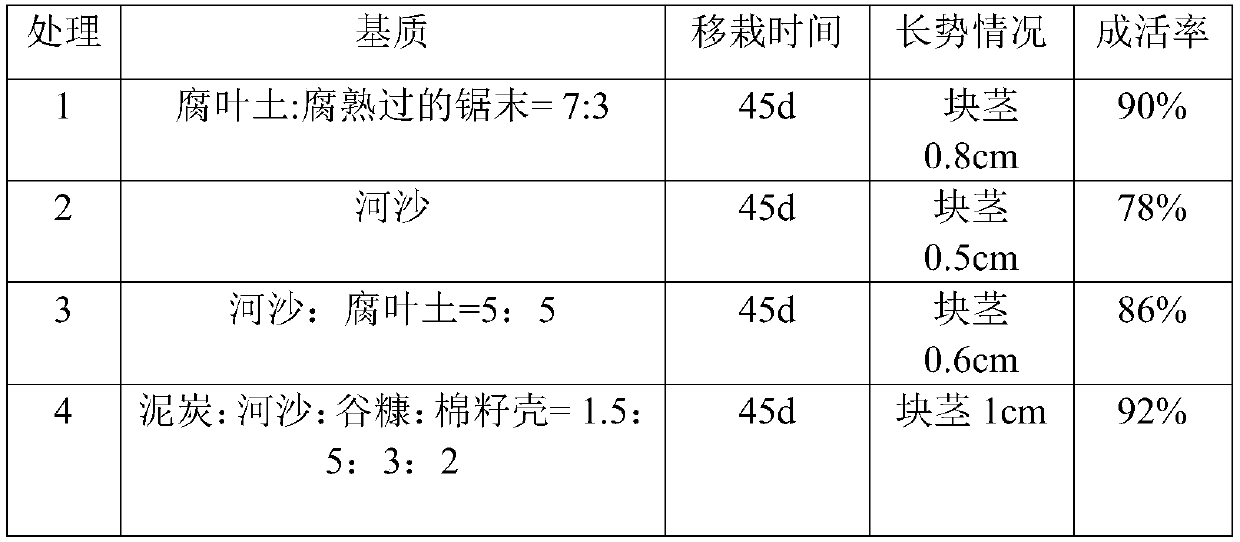Outdoor transplanting method of polygonatum sibiricum tissue culture seedlings
A technology for tissue culture of seedlings and Polygonatum chinensis, applied in the directions of botanical equipment and methods, cultivation, medium, etc., can solve the problems of low reproduction coefficient, long seedling raising time, limited provenance, etc., and achieve fast growth, prolong growth period, and take root. short time effect
- Summary
- Abstract
- Description
- Claims
- Application Information
AI Technical Summary
Problems solved by technology
Method used
Image
Examples
Embodiment 1
[0032] A kind of Polygonatum tissue culture seedling outdoor transplanting method, described method comprises the following steps:
[0033] S1: Transplanting substrate, transplanting test-tube seedlings, and plugs are pre-treated before transplanting:
[0034] S2: Transplanting period management:
[0035] S3: the plug seedlings are transplanted outdoors after 25-30 days;
[0036] Complete the outdoor transplanting of Polygonatum tissue culture seedlings.
[0037] Preferably, the transplanting substrate in the step S1 includes the following components in parts by weight: 1.5 parts of peat, 5 parts of river sand, 3 parts of rice bran, and 2 parts of cottonseed hulls.
[0038] Preferably, the method for treating the transplanted substrate in step S1 is: wet the substrate with 0.1% potassium permanganate aqueous solution, and cover it with a plastic film for 24 hours. Before mixing the matrix, the cottonseed hulls need to be fermented with water and high temperature for one mon...
Embodiment 2
[0050] Different substrates were changed, and the others were the same as in Example 1. The growth conditions are shown in Table 1.
[0051] Table 1 Polygonatum transplanted with different substrate growth conditions
[0052]
[0053] It can be seen from Table 1 that peat: river sand: chaff: cottonseed hull = 1.5:5:3:2, which is the best sowing substrate, the tuber growth time is 45 days, the first tuber is 1cm long, and the plant survival rate is 92% , which has a great increase in growth time and survival rate.
[0054] Table 2 embodiment 1 compares with routine processing
[0055]
[0056] As can be seen from Table 2, the optimization of the present invention and the conventional treatment shows that the rooting time is 10 days earlier than the conventional time, and the tubers of the present invention are 0.5cm larger than the conventional treatment in the same period, and the survival rate of the present invention is improved by 14% compared with the conventional t...
Embodiment 3
[0058] On the basis of Example 1, the transplanting substrate in the step S1 includes the following components by weight: 1.5 parts of peat, 5 parts of river sand, 3 parts of rice bran, 2 parts of cottonseed hulls, Maillard reaction product 1.5 servings. The production method of the Maillard reaction product is as follows: Weigh the same amount of glucosamine and xylan, dissolve them successively in 0.95%-1.2% glacial acetic acid solution, adjust the pH to 5.8-6 with 1mol / L sodium hydroxide solution, and place At 90-130°C, react for 25-35min to obtain the Maillard reaction product. See Table 3 for the growth conditions of Polygonatum Polygonatum transplanted in different substrates using the method of this embodiment.
[0059] Table 3 Rhizoma Polygonatum Transplanted Growth Situation
[0060]
[0061] As can be seen from Table 3, on the basis of the inorganic matrix of the present invention, adding a certain amount of chemical matrix, that is, the Maillard reaction produc...
PUM
 Login to View More
Login to View More Abstract
Description
Claims
Application Information
 Login to View More
Login to View More - R&D
- Intellectual Property
- Life Sciences
- Materials
- Tech Scout
- Unparalleled Data Quality
- Higher Quality Content
- 60% Fewer Hallucinations
Browse by: Latest US Patents, China's latest patents, Technical Efficacy Thesaurus, Application Domain, Technology Topic, Popular Technical Reports.
© 2025 PatSnap. All rights reserved.Legal|Privacy policy|Modern Slavery Act Transparency Statement|Sitemap|About US| Contact US: help@patsnap.com



